Chronic Hepatitis B (CHB) Market Research, 2031
The global chronic hepatitis b (chb) market was valued at $4.6 billion in 2021 and is projected to reach $6.2 billion by 2031, growing at a CAGR of 3% from 2022 to 2031. Hepatitis B is a viral infection that causes liver inflammation, sometimes leading to serious liver damage. The hepatitis B virus (HBV) spreads through contaminated blood. It can be diagnosed with an antibody test, genotype test, and viral load test. Chronic hepatitis B can be treated with antiviral drugs and immune modulators.
The increase in blood transfusion and donation rate contributes to the growth of the Chronic Hepatitis B Market Growth. The hepatitis B virus can be transferred through blood transfusion; hence hepatitis testing is mandatory for blood banks. Furthermore, an increase in the rate of hepatitis B and advancements in chronic hepatitis B (CHB) treatment drive the growth of the market. For instance, according to a report by the World Health Organization (WHO) published in June 2022, an estimated 296 million people were living with chronic hepatitis B infection in 2019, with 1.5 million new infections each year.
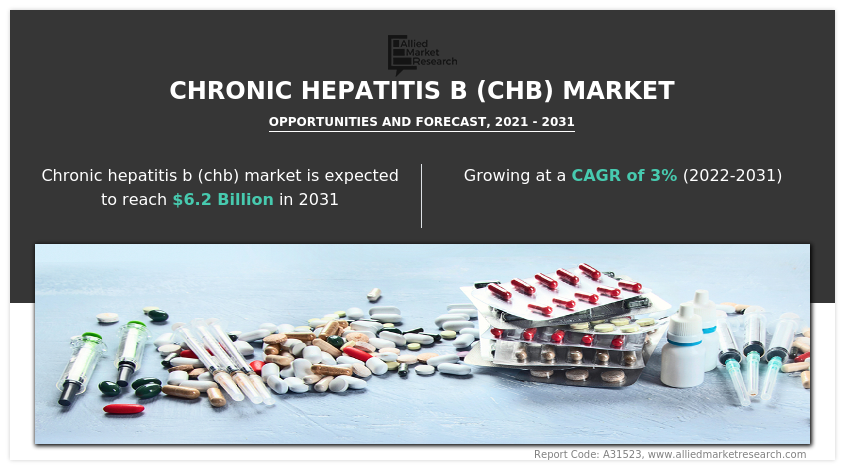
Moreover, the rise in demand for advanced chronic hepatitis B (CHB) treatment, the latest product launch, product approvals, and the presence of key players contribute to the growth of the Chronic Hepatitis B Market Size. In addition, an increase in R&D activities for the development of advanced and cost-effective chronic hepatitis B (CHB) fosters the growth of the Chronic Hepatitis B Market Size. For instance, in June 2022, Gilead Sciences, Inc., a leading biotechnology company announced Week 48 results from the Pivotal Phase 3 clinical trial evaluating the first-in-class entry inhibitor Hepcludex (bulevirtide) for the treatment of chronic hepatitis delta virus (HDV) infection. Thus, a rise in R&D activities and new product launches propel the growth of the market.
Furthermore, an increase in the number of diagnostic centers and blood banks drives the growth of the market. In addition, the regulating organizations of respective nations have established guidelines for blood banks and blood donations to avoid the spread of diseases. For instance, World Health Organization (WHO), recommends that all blood donations should be screened for infections prior to use. Screening for human immunodeficiency virus (HIV), hepatitis B, hepatitis C, and syphilis should be made mandatory. The increase in the diagnosis rate of hepatitis B virus infection drives the growth of the market.
In addition, growth in the number of hospitals, a surge in access to health care facilities globally, and increased health care expenditure drive the growth of the market. For instance, according to American Medical Association (AMA), health spending in the U.S. increased by 9.7% in 2020 to $4.1 trillion or $12,530 per capita. Moreover, the rise in government initiatives to provide improved healthcare facilities propels the growth of the Chronic Hepatitis B Industry. In addition, growth in the private hospital sector, Chronic Hepatitis B Industry, medical tourism, and ambulatory surgical clinics augment the growth of the market. Medical tourism provides healthcare services at a lower cost, which contributes to the adoption of medical services.
The chronic hepatitis B (CHB) market is segmented on the basis of drug class, gender, distribution channel, and region. By drug class, the market is fragmented into antivirals and immune modulators. By gender, the market is segregated into males and females. The male segment is further divided into adult and geriatric. The female segment is further divided into adult and geriatric. By end user, the market is categorized into hospital pharmacies, drug stores & retail pharmacies, and online providers.By region, the market is analyzed across North America (U.S., Canada, and Mexico), Europe (Germany, France, the UK, Italy, Spain, and the Rest of Europe), Asia-Pacific (Japan, China, Australia, India, South Korea, and Rest of Asia-Pacific), and LAMEA (Brazil, South Arabia, South Africa, and LAMEA).
The chronic hepatitis b (chb) market is segmented into Drug Class, Gender, and Distribution Channel.
By drug class, the antivirals segment dominated the market in 2021, and this trend is expected to continue during the forecast period, owing to improvements in healthcare infrastructure and the prevalence of infectious diseases. However, the immune modulators segment is expected to witness considerable growth during the forecast period, due to the prevalence of infectious diseases and the rise in R&D activities.
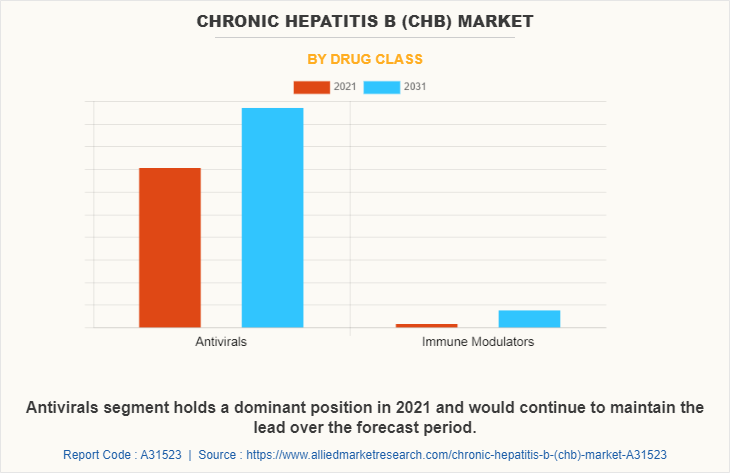
By gender, the male segment dominated the Chronic Hepatitis B Market Share in 2021, and this trend is expected to continue during the forecast period, owing to the high prevalence rate in men. However, the female segment is expected to witness considerable growth during the forecast period, due to an increase in female healthcare workers and a surge in healthcare expenditures.
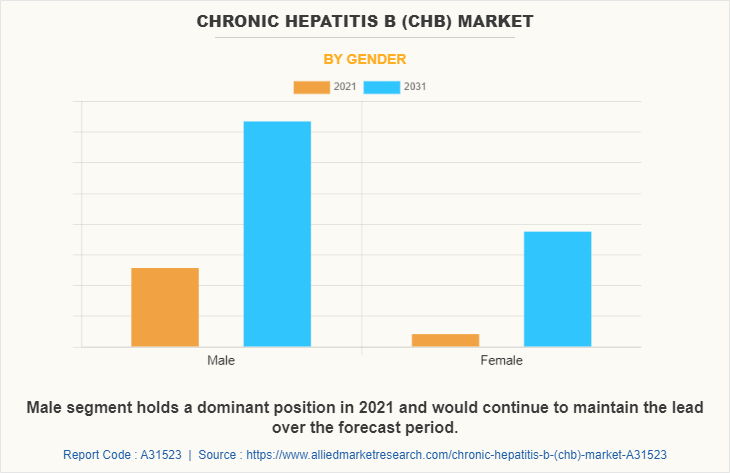
By distribution channel, the drug stores & retail pharmacies segment dominated the Chronic Hepatitis B Market Share in 2021, and this trend is expected to continue during the forecast period, owing to the rise in the number of drug stores & retail pharmacies and government initiatives to improve healthcare infrastructure. However, the online providers segment is expected to witness considerable growth during the forecast period, due to an increase in the number of online providers and a rise in the geriatric population.
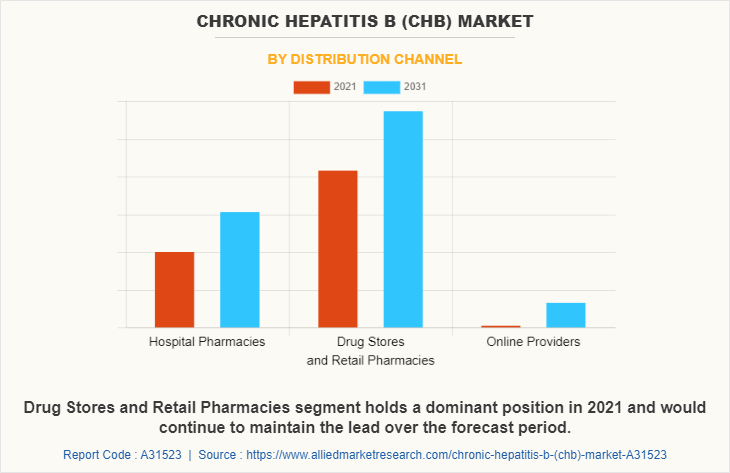
By region, North America garnered the major share in the chronic hepatitis B (CHB) market in 2021, and is expected to dominate the global market during the Chronic Hepatitis B Market Forecast period, owing to the rise in the incidence of chronic diseases, well-developed healthcare infrastructure, and the presence of key players. However, Asia-Pacific is expected to register significant growth, owing to a rise in the incidence of infectious diseases, improvements in the healthcare infrastructure, and the presence of a high population base.
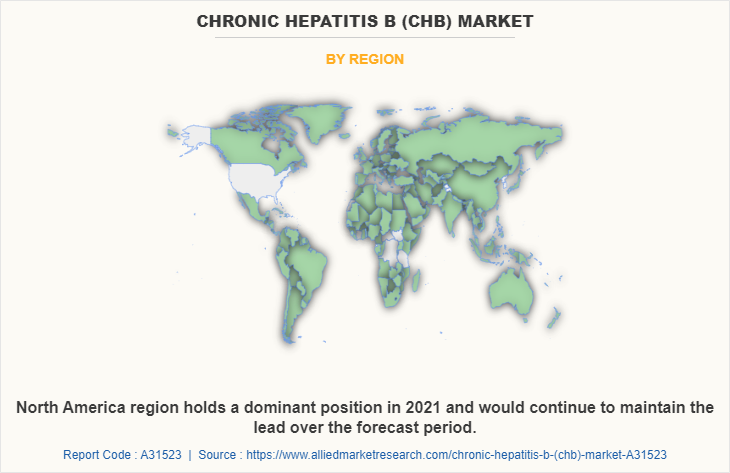
The key players operating in the global chronic hepatitis B (CHB) market are Biocon Inc, Cipla Limited, Dr. Reddy's Laboratories, Gilead Sciences, Inc., Novartis AG, Reliance Life Sciences, Sun Pharmaceutical Industries Limited, Teva pharmaceuticals, Viatris Inc and Zydus Cadila.
Key Benefits For Stakeholders
- This report provides a quantitative analysis of the market segments, current Chronic Hepatitis B Market Trends, estimations, and dynamics of the chronic hepatitis b (chb) market analysis from 2021 to 2031 to identify the prevailing Chronic Hepatitis B Market Opportunity.
- The market research is offered along with information related to key drivers, restraints, and opportunities.
- Porter's five forces Chronic Hepatitis B Market Analysis highlights the potency of buyers and suppliers to enable stakeholders make profit-oriented business decisions and strengthen their supplier-buyer network.
- In-depth analysis of the chronic hepatitis b (chb) market segmentation assists to determine the prevailing market opportunities.
- Major countries in each region are mapped according to their revenue contribution to the global market.
- Market player positioning facilitates benchmarking and provides a clear understanding of the present position of the market players.
- The report includes the analysis of the regional as well as global chronic hepatitis b (chb) market trends, key players, market segments, application areas, and market growth strategies.
Chronic Hepatitis B (CHB) Market Report Highlights
| Aspects | Details |
| Market Size By 2031 | USD 6.2 billion |
| Growth Rate | CAGR of 3% |
| Forecast period | 2021 - 2031 |
| Report Pages | 290 |
| By Drug Class |
|
| By Gender |
|
| By Distribution Channel |
|
| By Region |
|
| Key Market Players | Gilead Sciences, Inc., Viatris Inc. (Mylan NV), F. Hoffman La Roche, Ltd., Cipla Ltd, Teva Pharmaceutical Industries Limited, Novartis AG, GlaxoSmithKline (GSK), Merck & Co. Inc., Bristol Myers Squibb Co., zydus cadila |
Analyst Review
This section provides the opinions of the top-level CXOs in the chronic hepatitis B market. Hepatitis B is a liver infection caused by the hepatitis B virus (HCV). Hepatitis B is spread through direct contact with blood from an infected person.
Chronic hepatitis B can be treated with antivirals and immune modulators. Various antiviral drugs such as entecavir, tenofovir, lamivudine, adefovir, and telbivudine are used for the treatment of hepatitis B.
Factors such as an increase in the prevalence of hepatitis B, advancements in chronic hepatitis B treatment, and increase in diagnosis of hepatitis B drive the growth of the chronic hepatitis B market. In addition, an upsurge in blood transfusion rate and rise in healthcare expenditures of patients are expected to contribute toward the growth of the chronic hepatitis B market.
North America is expected to witness highest growth, in terms of revenue, owing to rise in the incidences of hepatitis B, the presence of key players for manufacturing & development of advanced chronic hepatitis B treatment, and well-established healthcare infrastructure in the region. However, the high cost of chronic hepatitis B is projected to hamper market growth.
The total market value of the chronic hepatitis B (CHB) market is $4589.8 million in 2021.
The forecast period in the report is from 2022 to 2031.
North America is the largest regional market for Chronic Hepatitis B (CHB).
The market value of the chronic hepatitis B (CHB) market in 2022 was $4750.44 million.
The top companies that hold the market share in chronic hepatitis B (CHB) market are Biocon Inc, Cipla Limited, Dr. Reddy's Laboratories, Gilead Sciences, Inc., Novartis AG, Reliance Life Sciences, Sun Pharmaceutical Industries Limited, Teva pharmaceuticals, Viatris Inc and Zydus Cadila.
The base year for the report is 2021.
The key trends in the chronic hepatitis B (CHB) market are an increase in the prevalence of chronic hepatitis B, advancements in chronic hepatitis B (CHB), and R&D in chronic hepatitis B (CHB) treatment.
Asia-Pacific is expected to register the highest CAGR of 4.7% from 2022 to 2031, owing to increase in prevalence of chronic hepatitis B, presence of key players, and high population.
Loading Table Of Content...



